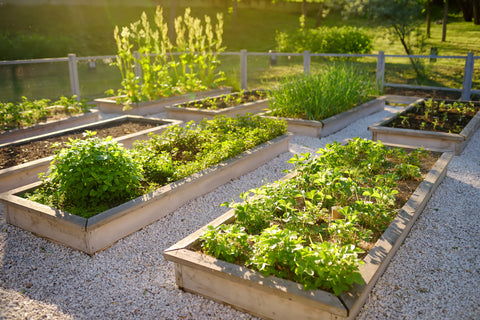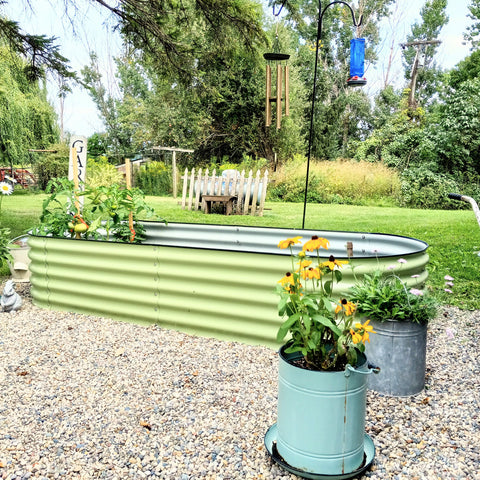Tips from Olle Garden Bed: How to Plant Asparagus
Planting asparagus requires a lot of advance planning and soil preparation. Unlike most garden vegetables, asparagus plants are perennial and can be grown for decades if taken care of properly. The following content also has some reference value for raised garden beds.
Patches that are poorly planted or poorly cared for may either be unproductive or wear out long before their time. On the other hand, a well planted asparagus bed has low maintenance cost, which can provide a family with delicious self-produced asparagus for a generation.
Planting Asparagus~Quick Start Guide

If you just want to quickly review how to plant asparagus, here are the basics:
Cold resistant area: 3 to 8
Soil pH: 6.5 to 8 (slightly alkaline)
Soil requirements: fertile, well drained, deep soil, completely free of weeds
Planting depth: 2 to 4 inches of soil above the crown, but the trench depth is 10-12 inches to accommodate all roots (see note below).
Plant spacing: 12 to 18 inches apart in a row, then leave at least 18 inches between rows in the bed (if you want to walk between rows, keep 3 feet between rows).
First harvest year: partial harvest in the second year, full harvest in the third year and after.
Where to plant asparagus
It is important to choose a good location when planting asparagus, because a piece of land can maintain 20+years of productivity. This is a long-term commitment. You should carefully consider your choice before planting.
Asparagus plants like fertile and well drained soil, which is a little alkaline (pH 6.5 to 8). If the pH is below 6, they will actually perform poorly, so stay away from plants that like acid (such as blueberries).
Since good drainage is important, if your soil is heavy or clay, consider planting asparagus on raised garden beds. We plant asparagus on the log elevated bed, and use a large amount of wood ash in the furnace to improve the soil to correct the pH value.
Asparagus plants will go deep into the root, so it is important to choose a planting site with deeper soil. At least, asparagus plants need at least 18 inches of fertile soil, preferably more to thrive.
In addition to soil considerations, it is also important to choose a sunny location when planting asparagus. Asparagus spears are harvested for about 6 weeks each spring, and then the plants need to be recharged in the rest of the summer to ensure the next year's harvest.
Each plant emits a few fern leaves 3-4 feet high. They are actually beautiful, but they take up a lot of space. Make sure you give them enough space to unfold and enough vertical space to reach the full height.

When to plant asparagus
Generally speaking, asparagus is planted by the annual crown and can only be purchased in spring. They are usually planted in March and April. Asparagus is planted much later in colder places than in temperate places.
Once there is an asparagus crown, once the soil can work in spring and is sufficiently dry from the snow melt, it is safe to plant asparagus. There is no need to wait until after the last spring frost. Planting outdoors in advance about 4 to 6 weeks before the last frost will ensure a good start in the growing season.
Although not very common, you can also use seeds to grow asparagus. Seed planting asparagus is an economic way to start the asparagus patch, but the plants need an additional year to mature.
In the first year of growth, the seedlings will develop crowns and strong roots. This is why asparagus crowns are often called "1 year old crowns", because they can give you a year ahead in the whole process.
Although the crown can only be purchased commercially in spring, planting asparagus in autumn is also an option. If you have a friend or neighbor who wants to send you some asparagus crowns, wait until the plants turn yellow and begin to die in late autumn.
Cut off the top of the growing asparagus and carefully pull up the asparagus crown by root. Planting asparagus crowns in autumn is the same as planting in spring, but be sure to cover the new autumn planting with a few inches of rotten dung to protect them from winter weather when they are established.
How to plant asparagus
When planting asparagus, soil preparation is very important. First dig a trench about 10 inches wide and about 10 inches deep. Backfill the bottom 2-3 inches of the trench with decaying compost or manure.
Asparagus plants need a lot of fertilizer to thrive. You only have one chance to put compost under the roots. Make sure you put enough food there to ensure they are full for a long time.
Asparagus plants need to be planted at least 12 inches in succession, preferably 18 inches apart, in order to grow strongly in the future. Once the ditch is backfilled or matured with decaying compost, a small mound is made every 12-18 inches using a little original soil in the ditch. Spread the asparagus roots on the soil pile and fan them in all directions.
Each mound should be about 4 to 6 inches high so that the top of the asparagus crown is within 2 inches of the soil level outside the ditch. Eventually, more soil will be added to bury the crown deeper, but in the first year, the top should be only 2 inches deep until the spear emerges from the soil.
At this time, you should have a row of asparagus crowns. Each crown is placed on a pile of soil, and its roots spread in all directions. The asparagus crowns are 12 to 18 inches apart in the row, and the top of the crown is about 2 inches lower than the surrounding soil level.
Once the first bud appears, add more soil at the top to form a mound. Ideally, you should add about 2 inches of fertile soil above each row to create a mound. This helps to bury the asparagus crown a little deeper, so they will eventually fall about 4 inches below the surface of the soil. The slightly depressed soil also helps to drain water and helps prevent asparagus plants from sitting in wet soil after heavy rain.
Here's a quick review
Start with a 10 inch groove
Add 2-inch compost (now 8-inch trench)
4-6 inch mound below each asparagus crown planting point
Place the crown on the mound and spread the roots (the crown top is now 2 inches below the soil level)
Soil backfilling
Let the asparagus appear and grow a few inches, then add about 2 inches of soil

How long is it to harvest asparagus
So now this million dollar question... How long is it before the first asparagus harvest?
In the first spring, after planting asparagus, the plants were still growing. I know it's tempting, but they need every such shot this year. Next spring, you can harvest a small amount of spears in about 2 weeks. That small mini harvest is enough for you to tide over the difficulties.
In the third spring after planting asparagus, you can actually harvest a full six week season. After 6 weeks, let the spear grow completely, and then leave the plant to collect energy for next year's crops.
